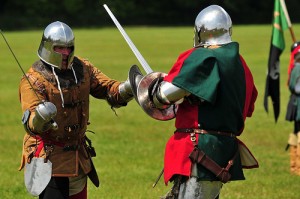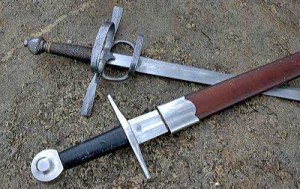Medieval Sword Fighting
Medieval sword fighting styles were brutal and far less elegant than those associated with the Renaissance. However, it was the first time in European history that a combat technique employed the art of self defence.
The fighting style was passed on from Italian and German training disciplines and encouraged blocking, increased attention to footwork, better shield and armour protection as well as mastering the practice of counter cutting.
Counter cutting was the technique of matching both offensive and defensive strategies in tandem and was intended to refine the rash rapier-orientated moves traditionally necessary for the battlefield.
The longsword was one of the most available weapons of the period, but only the aristocracy were permitted to own such a blade. It was often crafted to lengths of 1.2m and weighed as heavy as 2.4kg.
 Displaying a long cruciform hilt, it could be held with both hands and introduced the medieval fighting style known as ‘half-swording’ where the fighter places one hand on the hilt and one on the blade to control the weapon.
Displaying a long cruciform hilt, it could be held with both hands and introduced the medieval fighting style known as ‘half-swording’ where the fighter places one hand on the hilt and one on the blade to control the weapon.
Other areas of combat that were common included fighting with daggers and pole weapons, fencing with a single-handed sword and buckler (a type of shield) and armoured fighting.
Facts about swords
Longsword – A type of sword commonly used in medieval Europe, between 1250 and 1550. The sword itself could have reached as far as 1.2 metres and weighed up to 2.4kg.
 The small sword – The small, dress or court sword is famed for the decorative hilts and highly effective curved handles. It gained popularity during the 17th and 18th Century.
The small sword – The small, dress or court sword is famed for the decorative hilts and highly effective curved handles. It gained popularity during the 17th and 18th Century.
Japanese sword – A Japanese sword or nihonto is one of the most recognisable weapons of Japanese culture. Most commonly known is the katana, used by samurai.
Jian – are dual-edged Chinese straight swords (Dao are the single-edged variant), and have been used in the country for the past 2,500 years.
Flyssa – The flyssa is the traditional fighting sword used by the Kabyles tribe of Algeria and part of Morocco during the 19th Century. They varied in size from 12 to 38 inches.

